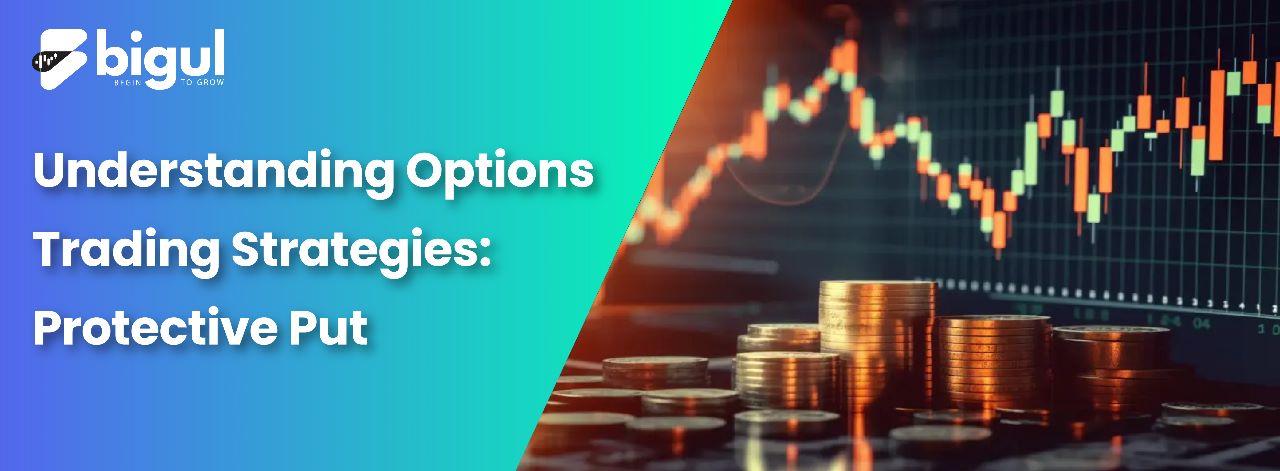Protective Put is a popular options trading strategy employed by investors seeking to safeguard their stock holdings against potential market downturns. This strategy acts as a protective shield for investors. It allows them to mitigate losses and manage risks effectively.
By purchasing put options, traders acquire the right to sell their underlying stocks at a predetermined price, known as the strike price, within a specified time frame. In this article, we dive deeper into the mechanics of Protective Put, when to use it and explore its benefits.
Also Read | Understanding Options Trading Strategies: Synthetic Put
What Is a Protective Put?
A protective put is a risk-management strategy investors use to safeguard their stock or asset holdings against potential losses. By purchasing a put option for a premium, investors can hedge their positions while maintaining a bullish outlook.
This strategy offers downside protection and functions as an insurance policy, mitigating losses if the price of the asset declines. Protective puts can be applied to various assets like stocks, currencies, commodities, and indexes, providing investors with a safety net in uncertain market conditions.
Example of Protective Put:
Let’s consider an example to illustrate the application of a protective put strategy. Let’s say you have 100 ABC Company shares at Rs 50 each. However, you’re worried about a market slump and want to preserve your investment.
To implement a protective put strategy, you purchase a one put option contract for ABC Company with a strike price of Rs 45 and an expiration date three months from now. The premium for the put option is Rs 2 per share, totalling Rs 200 (Rs 2 x 100 shares).
In this scenario, the protective put allows you to set a minimum selling price of Rs 45 per share for your ABC Company shares, regardless of any potential decline in the stock price. This ensures that your losses are limited if the stock value drops.
Now, let’s consider different outcomes:
Stock Price Above Strike Price: If the stock price remains above Rs 45, you can choose not to exercise the put option. In this case, you would only lose the premium paid for the put option (Rs 200). However, you would still benefit from any potential gains in the stock price.
Stock Price Below Strike Price: If the stock price drops below Rs 45, the put option becomes captivating. For example, if the stock price drops to Rs 40, you can exercise the put option, selling your shares for Rs 45 each. This limits your loss to Rs 5 per share (Rs 45 – Rs 40) instead of the potential larger loss without the protective put.
By employing a protective put strategy, you have effectively mitigated your downside risk, ensuring a minimum selling price for your shares and limiting potential losses in case of adverse market movements.
How Does a Protective Put Work?
Protective puts are frequently employed by investors who hold long positions in stocks or other assets. These puts act as a risk management tool, limiting potential losses if the asset’s price drops below the purchase price.
By purchasing put options, investors establish a predetermined floor price, ensuring they will not incur further losses as the asset’s price declines.
Put options provide the right, but not the obligation, to sell a specific quantity of the underlying security at a predetermined price before or on the expiration date. Each option contract represents 100 shares of the underlying asset.
When to Use the Protective Put Strategy?
Careful planning is essential to safeguard against unexpected price declines in a stock you’re optimistic about. The protective put strategy should be employed exclusively when holding a long position in the stock.
Premiums of Protective Put
When executing a protective put strategy, investors have choices to make regarding the strike price and expiration date of the put option. Typically, investors select an out-of-the-money put option, where the strike price is lower than the current stock price, indicating a bearish outlook. While this choice does not offer complete protection, it comes at a lower cost.
For investors who are more concerned about stock price declines, the at-the-money put option is preferred. This more aggressive approach provides 100% protection against potential losses but comes with a higher premium cost. Additionally, long-term protective puts generally carry higher premiums. Careful consideration of these factors is crucial when implementing a protective put strategy.
Benefits of Protective Put
Protective puts offer several benefits to investors as a risk-management strategy.
- Predetermined Minimum Selling Price: Firstly, they establish a predetermined minimum selling price for shares, effectively limiting potential losses associated with owning a stock. This provides a sense of security, particularly in volatile market conditions.
- Capitalise on Potential Gains: Secondly, since purchasing a put option is not obligatory, investors can still capitalize on potential gains if the stock price experiences a significant upward movement. The flexibility of the strategy allows investors to participate in favourable market trends without being restricted by the protective put.
- Virtually Unlimited Profit: Additionally, the potential for profit is virtually unlimited, as owning the stock enables investors to benefit from its rising value. This means that while the protective put provides downside protection, investors can still take advantage of the stock’s upward potential.
To calculate the maximum loss using this strategy, one would need to add the cost of the long put to the difference between the stock price and the long put. This calculation helps investors assess their risk exposure and make informed decisions regarding the use of protective puts.
Conclusion
The protective put is a valuable options trading strategy that allows investors to guard against potential losses while maintaining a bullish outlook on a stock. By purchasing put options, investors can set a minimum selling price for their shares, providing downside protection in volatile markets.
While there are risks associated with the cost of premiums and missed opportunities for higher profits, the protective put offers a means to manage risk and navigate uncertain market conditions. Careful planning and evaluating the specific situation are key to effectively implementing this strategy.
Also Read | Understand Long Call Butterfly Strategies in Options Trading

.jpg)






.jpg)
.jpg)
